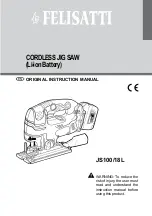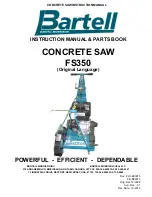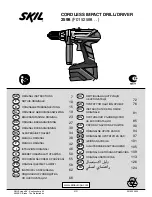
8
Installing or removing saw blade
CAUTION:
•
Always clean out all chips or foreign matter
adhering to the blade and/or blade holder. Failure
to do so may cause insufficient tightening of the
blade, resulting in a serious personal injury.
•
Do not touch the blade or the workpiece
immediately after operation; they may be
extremely hot and could burn your skin.
•
Tighten the saw blade securely. Failure to do so
may cause a serious injury.
•
When you remove the saw blade, be careful not to
hurt your fingers with the top of the blade or the
tips of workpiece.
1
2
013992
Before installing the blade, make sure that the blade
holder is in the released position.
To install the blade, insert the blade (teeth facing
forward) into the blade holder until it latches. The blade
holder moves to the fixed position by itself and the blade
is locked. Pull the blade lightly to make sure that the
blade does not fall off during operation.
CAUTION:
•
Do not open the tool opener excessively, or it may
cause tool damage.
Fig.6
To remove the blade, push the tool opener forward as
far as it will go. This allows the blade to be released.
NOTE:
•
Occasionally lubricate the roller.
Hex wrench storage
Fig.7
When not in use, store the hex wrench as shown in the
figure to keep it from being lost.
Cover plate
Fig.8
Use the cover plate when cutting decorative veneers,
plastics, etc. It protects sensitive or delicate surfaces
from damage. Fit it on the back of the tool base.
Anti-splintering device
Fig.9
For splinter-free cuts, the anti-splintering device can be
used. To install the anti-splintering device, move the tool
base all the way forward and fit it from the back of tool
base. When you use the cover plate, install the anti-
splintering device onto the cover plate.
CAUTION:
•
The anti-splintering device cannot be used when
making bevel cuts.
Dust extraction
The dust nozzle (optional accessory) is recommended
to perform clean cutting operations.
Fig.10
To attach the dust nozzle on the tool, insert the hook of
dust nozzle into the hole in the base.
Fig.11
To secure the dust nozzle, tighten the clamp screw at
the front of the dust nozzle.
The dust nozzle can be installed on either left or right
side of the base.
Fig.12
Then connect a Makita vacuum cleaner to the dust
nozzle.
OPERATION
CAUTION:
•
Always hold the base flush with the workpiece.
Failure to do so may cause blade breakage,
resulting in a serious injury.
NOTE:
•
If the tool is operated continuously until the battery
cartridge has discharged, allow the tool to rest for
15 minutes before proceeding with a fresh battery.
Fig.13
Turn the tool on without the blade making any contact
and wait until the blade attains full speed. Then rest the
base flat on the workpiece and gently move the tool
forward along the previously marked cutting line.
When cutting curves, advance the tool very slowly.
Bevel cutting
Fig.14
CAUTION:
•
Always be sure that the tool is switched off and the
battery cartridge is removed before tilting the base.
With the base tilted, you can make bevel cuts at any
angle between 0° and 45° (left or right).
Fig.15
To tilt the base, loosen the bolt on the back of the base
with the hex wrench. Move the base so that the bolt is
positioned in the center of the bevel slot in the base.
1. Fixed position
2. Released position









































